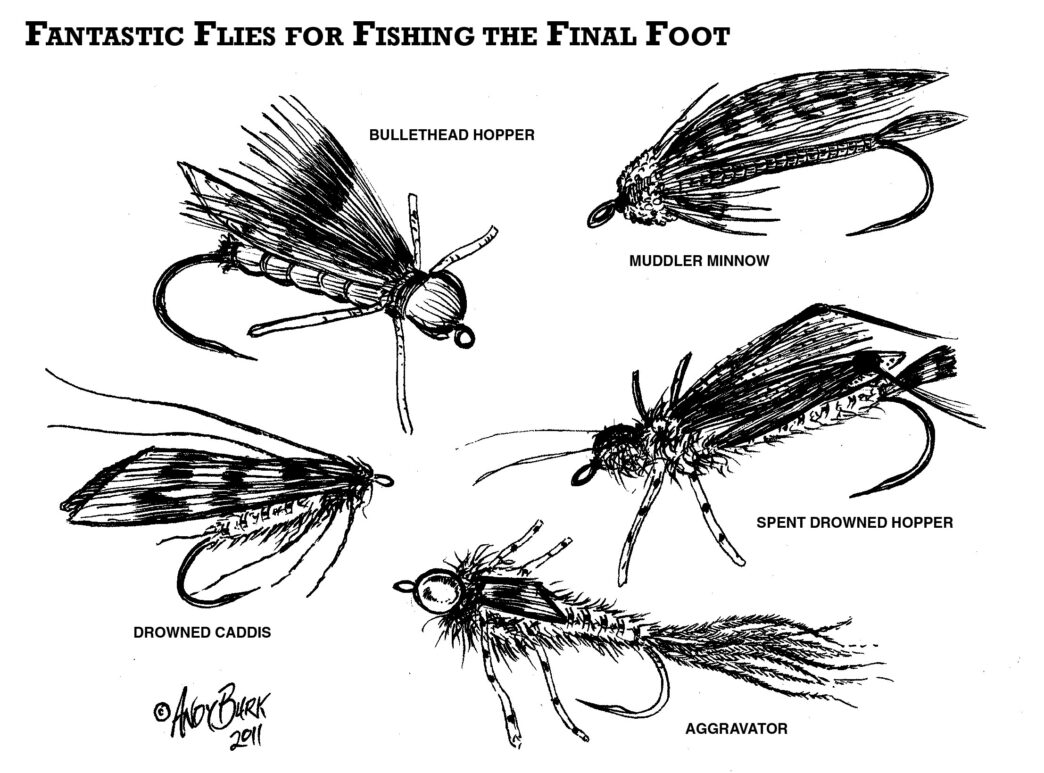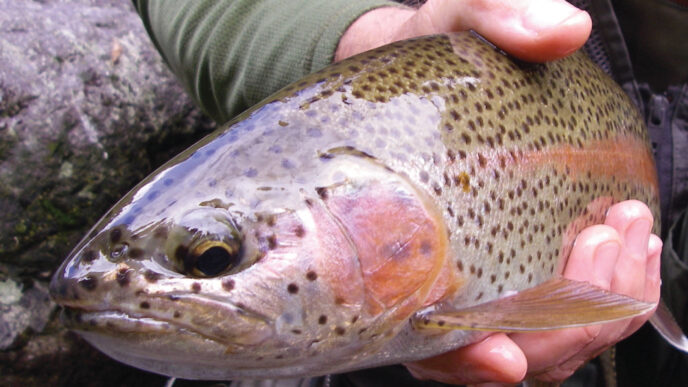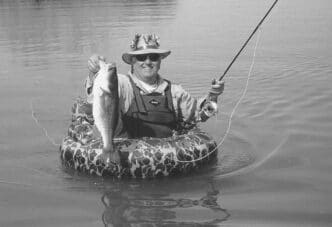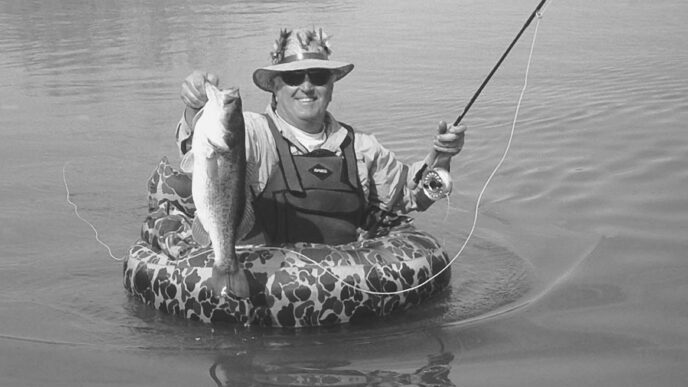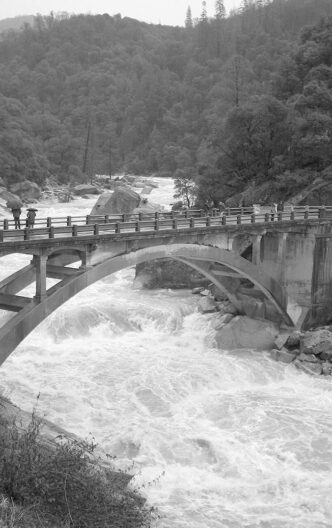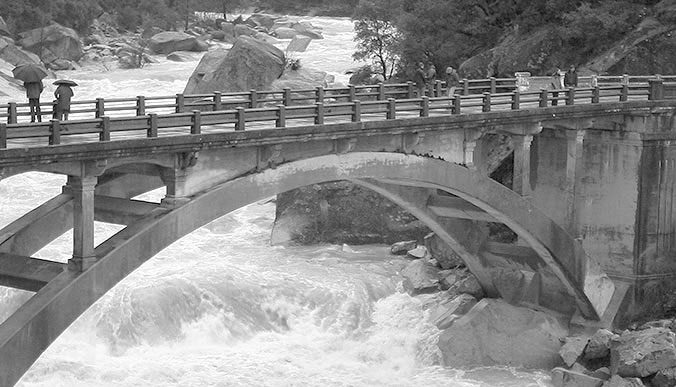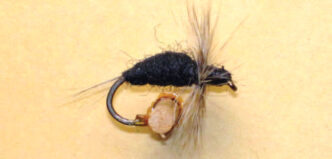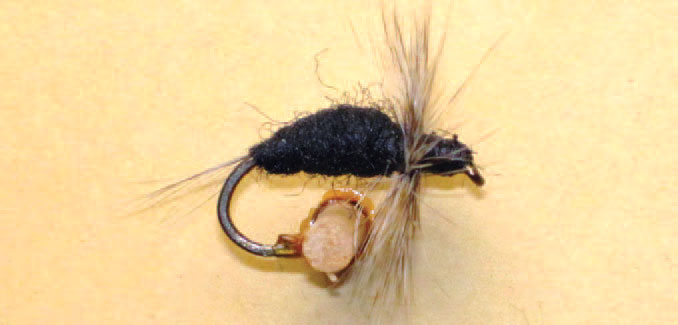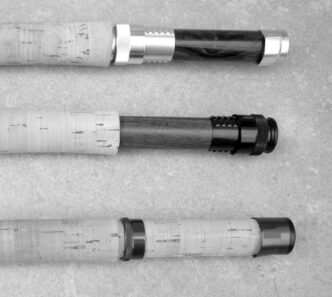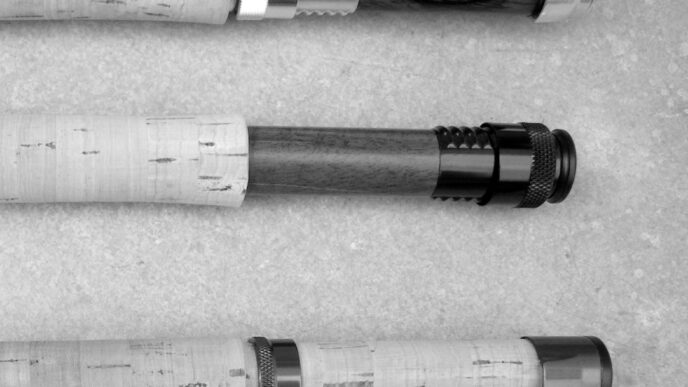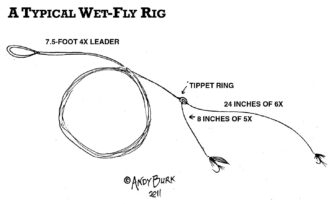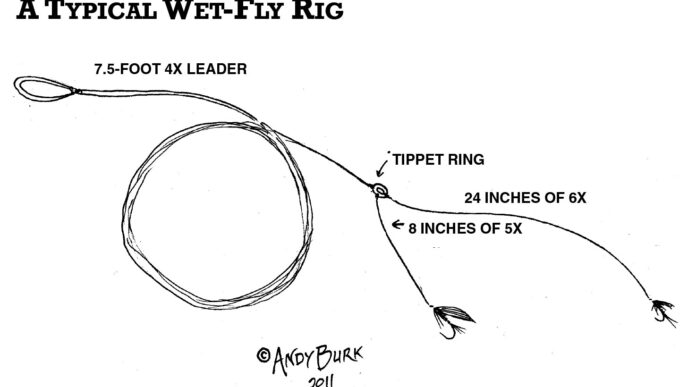The “final foot” is the area from the water’s surface down to a depth of one foot. This is one of the stream’s most important action zones. Every insect that emerges from the stream must swim through the final foot. Every creature that falls into the river ends up swimming, struggling and maybe drowning and dying in the final foot. Egglaying insects complete their life cycle, drown, and die in the final foot. Baitfish, small trout, and crayfish are also frequent visitors to the final foot, particularly when they are in panic-and-run-away mode.
I crept up the bank using the boulders and willows as cover, keeping my profile low to avoid spooking fish lying near the bank. In position, I unhooked the fly from the keeper and made a short cast just upstream of the boulder-lined bank. The small hopper pattern lazily sank, its pale yellow color just visible as a smudge three or four inches deep. Then it vanished in a flash of buttery gold, and instinctively, I raised the rod tip and felt the satisfying surge of a hooked trout. In the net, the brown trout was an impressive creature, beautiful, with the hopper firmly lodged in the corner of its jaw. Examining the fly, I saw that it was well chewed and now had no hope of floating. . . in other words, it was perfect — perfect to fish as a sunken drowned hopper in the final foot of the water column.
The “final foot” is what I call the area from the water’s surface down to a depth of one foot. This is one of the stream’s most important action zones. Why call it the “final foot,” when it’s the top foot of the stream, not the bottom? Because almost everything that happens on the stream passes through there on its way to happening. Every insect that emerges from the stream must swim through there. Every creature that falls into the river ends up swimming, struggling and maybe drowning and dying there. Egg-laying insects complete their life cycle, drown, and die there. Baitfish, small trout, and crayfish are also frequent visitors to this zone, particularly when they are in panic-and-run-away mode. Basically everything that trout like to eat passes through this zone, often in the final moments of its life or in the final moments of its metamorphosis.
Joe Average Angler usually ignores the final foot. Joe arrives at the stream with his rod already rigged with an indicator nymph system. He fishes this way throughout most of the day, carefully adjusting his indicator to keep his pair of nymphs deep in all the different runs and pockets that he fishes. Joe happily catches a few fish and is even more happy to catch a few on caddis dry flies as evening falls.
Joe has by all accounts had a pretty good day on the water, catching a fair number of fish on his two chosen rigs. But Joe spent his day fishing near the bottom or right on the top. The only time his nymphs spent in the final foot was a quick second or two as they either sank or were yanked up for another cast. And his dries floated above it the whole time. Joe has missed out on some excellent opportunities to catch fish by doggedly adhering to a system that works for him. Let’s enlighten Joe by telling him all about fishing the final foot.
As we’ve established, there can be a lot going on in this final foot, and once you start to study and fish this upper level of the water column regularly, you’ll be more than pleased with the results. The most obvious and often the most important area where action occurs in the final foot is near the bank, especially where the water is one to three feet deep and studded with boulders, wood, and other potentially fish-holding cover. This is by far my favorite area to fish the final foot, because the structure allows me to get within 15 to 20 feet of the target area, giving me optimum visibility of my fly, line, and leader. More importantly, if conditions are right, I’m able to see the flash or movement of fish underwater as they intercept my fly in the final foot.
Stealth is critical when you are stalking the bank hoping to catch fish within a foot of the surface. Fish lying near the bank are sensitive to abnormal sounds and movements in their world. Anglers who blast along the bank, standing atop every large boulder they come across and firing casts all over the place, rarely, if ever, see some of the large trout that regularly inhabit the near-bank habitat. You must walk slowly and softly, crouching low and using available streamside camouflage, and your casts, though short, must also be delicate. Dress in drab-colored clothing, too. Bright hats and white T-shirts are quick tickets to a fishless day.
I rarely see the fish that I catch along the bank zone until they take my fly. Most of the time, when I am fishing the final foot near the bank, I am fishing blind, casting to likely areas, rather than to specific fish I’ve spotted. By creeping patiently along the bank, I’ve had many instances where fish have taken the fly just a few feet from me.
Casting and Presentation
The more accurately and delicately you can present your fly, the more fish you will catch. The best way to develop these skills is on the water with rod in hand. When fishing the final foot, you are targeting fish that are lying on or near the bottom or near or under hard cover, such as a log or rock ledge, as well as those fish that are hovering in or just below the final foot. If you smack the fly down too hard, the fish in the final foot can easily be spooked and spook fish that are lying deeper in the flow. I strive for a presentation that lets the fly hit the water with a delicate . . . plop. I use a very soft hand in my cast, not trying for ultratight loops, but instead trying for very accurate control of a relatively open loop.
It works best for me if I relax my grip on the rod handle and slow down my casting pace. Work hard at relaxing, not at zinging out your casts, and soon you’ll be plopping your fly gently into the water within inches of your target every time. You’ll know you’re getting better when you start catching larger fish within inches of the surface and often within inches of the river bank.
What to Use?
When fishing the final foot, you’ll need to avoid heavily weighted flies and beadhead flies. Instead, choose lightly weighted or unweighted flies that will linger in the final foot for the longest amount of drift time. I have found using dry flies without floatant to be very effective in the final foot. Often, I’ll rub a little streamside mud on a dry fly to encourage its sinking qualities. Anytime larger insects are around, drowned imitations of them will get attention from trout, often more so than traditional dry or nymph patterns. October Caddises, stoneflies, drakes, and hoppers are all very effective fished from just under the surface to a foot deep. I tie lighter versions of my Aggravator nymphs in size 8 and 10 to fish there, as well. And terrestrial imitations are obvious choices to fish in the final foot near the bank. Look at streamside vegetation, and you’ll see all manner of beetles, ants, spiders, and other land dwellers that commonly drown in the final foot.
I prefer to fish larger flies, if I can, because I can often see them well as they drift in the final foot. My favorite throughout the summer months is a simple hair hopper pattern with Sili Legs. When I don’t treat this fly with floatant, it sinks verrrrry slowly and catches a lot of fish for me. If I tie the fly with lighter-colored hair, it is very easy to see under the surface. Standard Woolly Buggers are a great choice, as are crayfish patterns that aren’t weighted too heavily. The venerable Muddler Minnow is an excellent fly for the final foot. It might even lead my “If I only had one fly to fish” list for the final foot. Fortunately it’s just part of the arsenal, not the only weapon. Be flexible and experiment with different flies when fishing the final foot, using hatches and streamside experience to guide your fly selection.
Getting the Take
So now you’re ready to fish. You have an unweighted streamer tied to your 71/2-foot leader, and after checking the knot, you rub a little mud and goo from the stream bank onto the fly. You are slowly moving up a long riprap bank that has the occasional overhanging tree branch. You start with a short cast, 10 or 15 feet, watching the fly from the second it hits the water. As the fly slowly sinks, you can barely make out its color under the water. A rainbow trout darts up, then down. You quickly raise the rod, and the hook sticks deep in the corner of the fish’s jaw.
Later, with the water from the net dripping down your back and your spirits high, you continue up the bank. Soon, 50 yards of bank is behind you with only the one fish. It’s time for a fly change. A drowned hopper imitation is soon securely knotted to the leader.
Ten more yards of bank behind you and no takes. Maybe it’s time for a little provocation. The cast is made and, as the hopper slowly sinks, you lift the rod tip slightly several times through the course of the drift, imparting a simulation of life to the fly. Just a little . . . twitch. Then there is the flash, and you lift the rod tip and set the hook.
Always keep in mind that the zone that you are fishing is the zone of death for the critters that fall into it and often becomes the zone of death for creatures that are swimming up through it. This means that it is often to your advantage to impart a struggling motion to your fly. However, the key is to not get too carried away with moving the fly. I like to use very subtle twitches of the rod tip to move the fly just a little bit, usually no more than an inch or two, at most
Once you get into the game of fishing the final foot, you’ll start to develop a feel for how best to fish the final foot of different types of water. It’s an enjoyable learning process, with half of the fun in playing puppeteer with the fly, using subtle rod-tip twitches and micromends to give it life.
Visualize your fly as a newly submerged or newly emerged struggling or drowning creature and manipulate it accordingly with rod and line. There’s no end to the variations on the game that you can play.
Multiple-Fly Rigs? Indicators?
Indicators and multiple-fly rigs obviously can be useful in fishing the final foot, but may not always be the answer for greater success. Since you are concentrating your efforts in the upper foot of the water column, the indicator must be very close to the fly — close enough that I think the use of an indicator does more harm than good. I’ve just seen too many fish flare away from the indicator-and-fly combination when the indicator and the fly are near each other. I do use small indicators when fishing the upper foot in midstream or when visibility is challenging. More often, if I’m fishing midstream, I use a dry fly as an indicator. The best nonfly indicators to use for the final foot are either those gummy-backed little pinch-on versions or tiny yarn indicators made with polypropylene yarn. Feel free to experiment. Success will determine the indicator that you should choose.
Final Thoughts on the Final Foot
Once you start catching a few fish just shy of the water’s surface, and you achieve the confidence needed to consistently score there, you’ll really start having fun. Most of the time, I end up fishing with
folks who really like to move as they fish. This works great for me, because the water that they pass by as they move upstream or down is usually ripe for stalking the final foot, after it’s been rested for an hour or so. Plus, all those people who get in and out of the stream are sure to knock lots of critters from the shoreline zone into the final foot to drown and be eaten.
I’ve spent the past couple of years becoming a real student of the final foot, and the more I fish it, the more people I find who seem to be in on the secret. My fishing buddy, the guide Jim Landis, is one of the biggest fans of the final foot. While hanging out and tying some flies a few years ago with Jim, I whipped up some sunken spent hopper patterns and gave him a few to try out. He returned several hours later with a fat, foil-wrapped burrito from a local Mexican restaurant. Setting the burrito on my tying table, he smiled, “Could you show me how to tie that thing?” Needless to say, Jim got a quick tying lesson.
It’s very addictive, fishing this upper foot. I know that there have been plenty of times in the past two years when I really could have cleaned up using a nymphand-indicator rig in the riffles or pounding the pocket water with a dry, but there is just something special about fishing in the zone where it seems as if most of the fish you catch are fish that you made come up from their lie to eat. For me it’s every bit as good as the rise to a dry fly.




